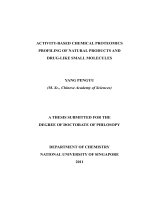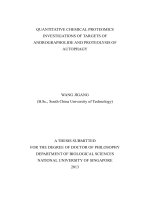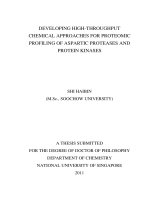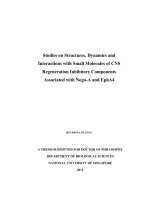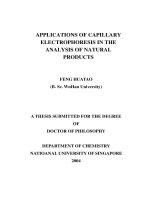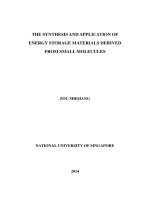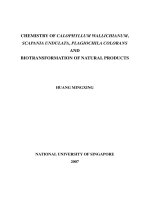Activity based chemical proteomics profiling of natural products and drug like small molecules
Bạn đang xem bản rút gọn của tài liệu. Xem và tải ngay bản đầy đủ của tài liệu tại đây (12.82 MB, 446 trang )
ACTIVITY-BASED CHEMICAL PROTEOMICS
PROFILING OF NATURAL PRODUCTS AND
DRUG-LIKE SMALL MOLECULES
YANG PENGYU
(M. Sc., Chinese Academy of Sciences)
A THESIS SUBMITTED FOR THE
DEGREE OF DOCTORATE OF PHILOSOPY
DEPARTMENT OF CHEMISTRY
NATIONAL UNIVERSITY OF SINGAPORE
2011
ii
This thesis is dedicated to my parents, my wife and my daughter.
Acknowledgements
It is my great pleasure to take this opportunity to express my
acknowledgements to all the people who have helped or encouraged me during my
PhD project. First, I would like to express my deepest appreciation to my supervisor
Prof. Yao Shao Q., for his support and guidance throughout the research. His
continued support led me to the right way. His intensity, creativity, passion and
dedication to science is admirable. Prof. Yao has allowed me great freedom in
developing projects to work on in his lab and has always been supportive of the
collaborations that led to much of my work. The diverse, interdisciplinary nature of
Prof. Yao’s research program is one of the things that drew me to his group in the first
place, and I have learned much by being in such an environment
Special thanks to my collaborators for their excellent work including: Wang
Min and Prof. He Cynthia Y. for their patience and support from my first days
learning T. brucei to my final days working out these manuscripts; Mun Hong and
Prof. James M. Lear for their contribution on library contruction.
Many researchers provided me their reagents or expertise. I would like to
thank them here: Prof. Christopher J. Chang (University of California, Berkeley) for
the bacterial His-AGT plasmid, mammalian plasmids FLAG-Cox8A-SNAP,
FLAG-H2B-SNAP, FLAG-KDEL-SNAP, FLAG-NK1R-SNAP, mCherry-Cox8A, and
mCherry-KDEL; Dr. Conor R. Caffrey and Prof. James H. McKerrow (University of
California, San Francisco) for cruzain and rhodesain as well as anti-rhodesain and
iv
anti-TbCatB; Prof. Siu Kwan Sze (Nanyang Technological University, Singapore) for
his support for LC-MS/MS experiments.
I am truly grateful to all the labmates past and present. Especially I would
like to thank Liu Kai, Raja, Wu Hao, Mingyu, Grace, Li Lin, Shen Yuan, Su Ling, and
Mei Yin for their help and contribution. I would like to thank Hongyan, Haibin, Lay
Pheng, Liqian, Candy, Jinyan, Su Ying, Xiamin, Chongjing, Zhenkun, and Xiaoyuan
for their friendship. It is my great pleasure to study in such a friendly lab atmosphere.
I would like to thank the members of my thesis committee: Prof. Lu Yixin,
Prof. Tan Choon Hong and Prof. James M. Lear for their input and helpful
suggestions of my research projects.
I also acknowledge kind support from NUS for providing me research
scholarship. Thanks also go to Department of Chemistry administrative staffs for their
supports, especially Suriawati Bte Sa'Ad for her help on all kinds of issues.
Finally, I am grateful to my family and friends for their constant support and
encouragement. I own my parents and parents-in-law for their endless love and
support for my study. I am in debt to my brother and my sister, who takes care of my
parents when I study abroad. I am deeply indebted to my wife Baiyun, for her endless
love, support, and encouragement at all times. Without her support, this thesis work is
impossible. My love to my daughter Guyu, cheers me up with her cute smile, her
endless curiosity, her naughty requests, and sometimes even her cries. I would like to
thank my friends – Zhibin, Lifa, Yunben, Yujun and their families – for their
friendship and help.
v
Table of Contents
Page
Dedication
iii
Acknowledgements
iv
Table of Contents
vi
Summary
x
List of Publications
xii
List of Abbreviations
xv
List of Figures
xxi
List of Schemes
xxv
List of Tables
xxvi
Chapter 1: Introduction
1
1.1 Drug Target Identification – An Overview
2
1.2 Activity-Based Protein Profiling (ABPP)
5
1.2.1 Introduction
5
1.2.2 Activity-Based Probe Design
7
1.2.3 Bioorthogonal Chemistry in ABPP
10
1.2.4 Application of ABPP for Target ID of Natural Products
17
1.2.5 Application of ABPP for Imaging of Protein Activities
20
Chapter 2: Activity-Based Proteome Profiling of Potential Cellular Targets
24
of OrlistatTM
Abstract
25
vi
2.1 Introduction
26
2.2 Results and Discussion
28
2.2.1 Design of Orlistat-like Probes
28
2.2.2 Retrosynthetic Analysis of THL-R
31
2.2.3 Synthesis of three Orlistat-like Probes
32
2.2.4 Effects on Cell Proliferation, Phosphorylation of eIf2
36
and Activation of Caspase-8
2.2.5 In Situ and In Vitro Proteome Profiling
39
2.2.6 Cellular Target Identification and Validation
43
2.2.7 Cellular Imaging
48
2.2 Conclusion
Chapter 3: Chemical Modification and Organelle-Specific Localization of
50
51
Orlistat-Like Natural-Product-Based Probes
Abstract
52
3.1 Introduction
53
3.2 Results and Discussion
56
3.2.1 Design of a Library of Orlistat-Like Probes
56
3.2.1 Synthesis of Sixteen Orlistat-Like Probes
59
3.2.2 Biological Screening
62
3.2.3 In Situ Proteome Profiling and Target Identification
63
3.2.4 Design and Synthesis of an AGT/SNAP-Orlistat
74
Bioconjugate as the Organelle-Targetable Probe
vii
3.3 Conclusion
Chapter 4: Parasite-Based Screening and Proteomic Profiling Reveal
80
82
OrlistatTM, an FDA-Approved Drug, as a Potential Anti-Trypanosoma
brucei Agents
Abstract
83
4.1 Introduction
84
4.2 Results and Discussion
88
4.2.1 Trypanocidal Activities of Orlistat-Like Probes in T.
88
4.2.2 Comparative in Situ Proteomic Profiling of T. brucei
96
4.2.3 Putative Target Identification and Validation of Both
101
brucei
PCF and BSF Trypanosomes
4.2.4 Cellular Uptake and Morphological Changes of T. brucei
109
upon Probe Treatment
4.3 Conclusion
Chapter 5: Activity-Based Chemical Proteomics Cellular Target Profiling
115
117
of K11777, a Clinical Cysteine Protease Inhibitor
Abstract
118
5.1 Introduction
118
5.2 Results and Discussion
120
5.2.1 Design of K11777-like Probes
120
5.2.1 Synthesis of K11777-like Probes
123
viii
5.2.2 Effects on Trypanocidal Activities of Probes
126
5.2.3 In Situ Proteome Profiling and Target Identification
127
5.2.4 Cellular Imaging
132
5.3 Conclusion
Chapter 6: Design, Synthesis and Biological Evaluation of Potent
135
136
Azadipeptide Nitrile Inhibitors and Activity-Based Probes as Promising
Anti-Trypanosoma brucei Agents
Abstract
137
6.1 Introduction
138
6.2 Results and Discussion
142
6.2.1 Design and Synthesis of Aza-nitriles
142
6.2.2 Biological screening
147
6.2.3 Design and Synthsis of Activity-based Probes
154
6.2.4 In Situ Proteome Profiling
156
6.2.5 Cellular Imaging
162
6.3 Conclusion
166
Chapter 7: Concluding Remarks
168
Chapter 8: Materials and Methods
169
Chapter 9: References
288
Appendix 1
312
Appendix 2
323
Appendix CD
ix
Summary
Assigning the cellular target(s) of bioactive small molecules, whether the
compounds are discovered by cell-based phenotypic or target-based screens of
chemical libraries, remains an ongoing challenge. The ability of accurately and
thoroughly determining of SMtarget interaction profiles as well as mapping of
metabolic and signaling pathways on the proteomic scale would therefore be more
illuminating, as it could provide invaluable biological insights for a drug candidate by
both understanding the primary mechanism-of-action, and at the same time, side
effects due to unexpected “off-target” interactions at a very early stage of drug
development, which should help to reduce the attrition rate in development. In many
cases such a capability could find new potential therapeutic value for an established
drug as well as it could also offer strong clues for compound optimization in order to
maximize the therapeutic potential and minimize potential cellular toxicity of a drug.
The data may also serve to define previously unknown protein functions, based on the
phenotypes induced by compounds. Recent advances in chemical proteomics (or
activity-based proteomics), a multidisciplinary research area integrating biochemistry
and cell biology with organic synthesis and mass spectrometry, have enabled a more
direct and unbiased analysis of a drug’s mechanism of action in the context of the
proteomes as expressed in the target cell or the tissue of interest.
In this thesis, I describe the design and synthesis of OrlistatTM-like natural
product-based probes (Chapter 2, 3 & 4), K11777-like drug candidate-based probes
(Chapter 5) and azanitrile-containing small molecules (Chapter 6), determination of
x
structure-activity relationships of these compounds, cellular target identification,
validation and cellular localization in subsequent molecular biology and cell
biological experimentsin both living mammalian cells and Trypanosoma brucei
parasites.
xi
List of Publications
(2007-2011)
1.
P.-Y. Yang, M. Wang, K. Liu, M. H. Ngai, O. Sheriff, M. J. Lear, S. K. Sze, C. Y.
He, S. Q. Yao, Parasite-Based Screening and Proteomic Profiling Reveals Orlistat,
an FDA-Approved Drug, as a Potential Anti-Trypanosoma brucei Agent. Chem.
Eur. J. 2012, submitted.
2.
P.-Y. Yang, M. Wang, H. Wu, L. Li, C. Y. He, S. Q. Yao, Design, Synthesis and
Biological
Evaluation
of
Potent
Azadipeptide
Nitrile
Inhibitors
and
Activity-Based Probes as Promising Anti-Trypanosoma brucei Agents. Chem. Eur.
J. 2012, in press.
3.
P.-Y. Yang, M. Wang, C. Y. He, S. Q. Yao, Activity-Based Proteome Profiling of
Potential Cellular Targets of K11777 - a Clinical Cysteine Protease Inhibitor.
Chem. Commun. 2012, 48, 835-837.
4.
P.-Y. Yang, K. Liu, C. Zhang, G. Y. J. Chen, Y. Shen, M. H. Ngai, M. J. Lear, S. Q.
Yao, Chemical Modification and Organelle-Specific Localization of Orlistat-Like
Natural Product-Based Probes. Chem. Asian. J. 2011, 6, 2762-2775.
5.
K. Liu, P.-Y. Yang, Z. Na, S. Q. Yao, Dynamic Profiling of Post-Translational
Modifications on Newly Synthesized Proteins Using a Double Metabolic
Incorporation Strategy. Angew. Chem. Int. Ed. 2011, 50, 6776-6781.
xii
6.
H. Wu, J. Ge, P.-Y. Yang, J. Wang, M. Uttamchandani, S. Q. Yao, A Peptide
Aldehyde Microarray for High-Throughput Detection of Cellular Events. J. Am.
Chem. Soc. 2011, 133, 1946-1954.
7.
M. Hu, L. Li, H. Wu, Y. Su, P.-Y. Yang, M. Uttamchandani, Q.-H. Xu, S. Q. Yao,
Multi-Color, One- and Two-Photon Imaging of Enzymatic Activities in Living
Cells with Novel Fluorescently Quenched Activity-Based Probes (qABPs). J. Am.
Chem. Soc. 2011, 133, 12009-12020.
8.
M. H. Ngai, P.-Y. Yang, K. Liu, Y. Shen, S. Q. Yao, M. J. Lear, Click-Based
Synthesis and Proteomic Profiling of Lipstatin Analogues. Chem. Commun. 2010,
46, 8335-8337. (Cover Feature Article)
9.
P.-Y. Yang, K. Liu, M. H. Ngai, M. J. Lear, M. R. Wenk, S. Q. Yao,
Activity-Based Proteome Profiling of Potential Cellular Targets of Orlistat an
FDA-Approved Drug with Anti-Tumor Activities. J. Am. Chem. Soc. 2010, 132,
656-666. (Highlighted by Faculty of 1000 Biology)
10. L. P. Tan, H. Wu, P.-Y. Yang, K. A. Kalesh, X. Zhang, M. Hu, R. Srinivasan, S. Q.
Yao, High-Throughput Discovery of Mycobacterium Tuberculosis Protein
Tyrosine Phosphatase (MptpB) Inhibitors Using Click Chemistry. Org. Lett. 2009,
11, 5102-5105.
11. R. Srinivasan, L. P. Tan, H. Wu, P.-Y. Yang, K. A. Kalesh, S. Q. Yao,
High-Throughput Synthesis of Azide Libraries Suitable for Direct “Click”
Chemistry and in situ Screening. Org. Biol. Chem. 2009, 7, 1821-1828.
xiii
12. P.-Y. Yang, H. Wu, M. Y. Lee, A. Xu, R. Srinivasan, S. Q. Yao, Solid-Phase
Synthesis of Azidomethylene Inhibitors Targeting Cysteine Proteases. Org. Lett.
2008, 10, 1881-1884.
13. S. L. Ng, P.-Y. Yang, K. Y.-T. Chen, R. Srinivasan, S. Q. Yao, “Click” synthesis of
small-molecule inhibitors targeting caspases. Org. Biomol. Chem. 2008, 6,
844–847.
14. K. A. Kalesh, P.-Y. Yang, R. Srinivasan, S. Q. Yao, Click Chemistry as a
High-Throughput Amenable Platform in Catalomics. QSAR Comb. Sci. 2007, 26,
1135–1144.
xiv
List of Abbreviations
Å
angstrom(s)
ABC
ammonium bicarbonate
ABPs
activity-base probes
ABPP
activity-based protein profiling
Ac
acetyl
ACC
7-aminocoumarin-4-acetic acid
ACN
acetonitrile
AGT
O6-alkylguanine-DNA alkyltransferase
aq.
aqueous
Ar
aryl, argon
BINOL
1,1'-bi-2-naphthol
br
broad
BG
benzylguanine
Bn
benzyl
Boc
tert-butyl-oxycarbonyl
BSA
bovine serum albumin
BSF
bloodstream form
Cat
cathepsin
δ
chemical shift in ppm
Cbz
benzyloxycarbonyl
calcd
calculated
CuAAC
copper (I)-catalyzed azide-alkyne cycloaddition
DCC
N, N’-dicyclohexylcarbodiimide
DCM
dichloromethane
dd
doublet of doublet
°
C
degrees Celsius
2D-GE
two-dimensional gel electrophoresis
xv
DIAD
diisopropyl azodicarboxylate
DIC
N, N’-diisopropylcarbodiimide
DIEA
N, N’-diisopropylethylamine
DIGE
differential gel electrophoresis
DMAB
dimethylamine borane
DMAP
4-dimethylaminopyridine
DMEM
dulbecco's modified eagle medium
DMF
N, N’-dimethylformamide
DMP
Dess-Martin periodinane
DMSO
dimethylsulfoxide
DNA
deoxyribonucleic acid
DTT
dithiothreitol
EA
ethyl acetate
E. coli
Escherichia coli
ED50
half-maximal effective dose
EDC
1-ethyl-3-(3-dimethylaminopropyl)carbodiimide
EDTA
ethylenediaminetetracetic acid
ee
enantiomeric excess
EI
electron ionization
emPAI
exponentially modified protein abundance index
equiv.
equivalent(s)
ER
endoplasmic reticulum
ESI
electron spray ionization
Et
ethyl
FAS
fatty acid synthase
FBS
fetal bovine serum
FDA
US food and drug administration
FITC
fluorescein isothiocyanate
Fmoc
9-fluorenylmethoxycarbonyl
xvi
g
gram(s)
GI
gastrointestianl
GST
glutathione S-transferase
h
hour(s)
HAT
human African trypanosomiasis
His-AGT
hexahistidine-tagged AGT
HOBt
N-hydroxybenzotriazole
HPLC
high performance liquid chromatography
Hz
hertz
IC50
half-maximal inhibitory concentration
ICAT
isotope coded affinity tag
IgG
immunoglobulin G
Imi
imidazole
IPI
international protein index
ISCF
isobutyl chloroformate
J
coupling constant
kDa
kiloDalton
KDEL
Lys-Asp-Glu-Leu (amino acid sequence)
LAH
lithium aluminum hydride
LC-MS/M
liquid chromatography tandem mass spectrometry
m
multiplet, meter(s)
M
molar
MALDI
matrix-assisted laser desorption/ionization
m-CPBA
m-chloroperbenzoic acid
Me
methyl
mg
milligram(s)
MHz
megahertz
L
microliter(s)
m
micrometer(s)
xvii
min
minute(s)
mL
milliliter(s)
mmol
millimole(s)
mM
millimolar
mol
mole(s)
m/z
mass-to-charge ratio
NHS
N-hydroxysuccinimide
NK1R
neurokinin 1 receptor
nM
nanomolar
NMM
N-methylmorpholine
NMR
nuclear magnetic resonance
p
para
PAGE
polyacrylamide gel electrophoresis
PBS
phosphate buffered saline
PBST
phosphate buffered saline with Tween-20
PCF
procyclic form
pH
hydrogen ion concentration
Ph
phenyl
PCR
polymerase chain reaction
PLS
protein localization sequence
ppm
parts per million
psi
pounds per square inch
PTM
post-translational modification
PVDF
polyvinyl difluoride
q
quartet
Q-TOF
quadropole-time-of-flight
RNA
ribonucleic acid
RNAi
RNA interference
s
singlet
xviii
sat
saturated
SAR
structure-activity relationship
SDS
sodium dodecyl sulfate
t
triplet
TAS-F
tris(dimethylamino)sulfonium difluorotrimethylsilicate
TBS
tert-butyldimethylsilyl
TBTA
tris[(1-benzyl-1H-1,2,3-triazol-4-yl)methyl]amine
tBu
tert-butyl
TCEP
tris(2-carboxyethyl) phosphine
TFA
trifluoroacetic acid
THF
tetrahydrofuran
THL
tetrahydrolipstatin
TLC
thin layer chromatography
TMAL
tandem Mukaiyama-aldol lactonization
TMS
tetramethylsilane
TOF
time of flight
Ts
toluenesulfonic acid
UV
ultraviolet
VS
vinyl sulfone
w/v
weight to volume ratio
w/w
weight to weight ratio
XTT
2,3-bis-(2-methoxy-4-nitro-5-sulfophenyl)-2H-tetrazolium-5-carboxan
ilide
Z
benzyloxycarbonyl
xix
List of Twenty Natural Amino Acids
Single Letter Code
Three Letter Code
Full Name
A
Ala
Alanine
C
Cys
Cysteine
D
Asp
Aspartate
E
Glu
Glutamate
F
Phe
Phenylalanine
G
Gly
Glycine
H
His
Histidine
I
Ile
Isoleucine
K
Lys
Lysine
L
Leu
Leucine
M
Met
Methionine
N
Asn
Asparagine
P
Pro
Proline
Q
Gln
Glutamine
R
Arg
Arginine
S
Ser
Serine
T
Thr
Threonine
V
Val
Valine
W
Trp
Tryptophan
Y
Tyr
Tyrosine
xx
List of Figures
Chapter 1
Figure 1.1
Page
Representative structures of molecules whose target
4
proteins were identified using affinity chromatography.
Figure 1.2
Comparison of conventional proteomic approaches &
6
ABPP and experimental workflows in ABPP.
Figure 1.3
Structures of probes based on reactive groups,
9
photoreactive groups and quinone methide or tosyl
chemistry.
Figure 1.4
Two-step ABPP labeling assisted by the bioorthogonal
12
reactions.
Figure 1.5
“Tag-free” probes for two-step ABPP labeling ordered by
13
enzyme or enzyme classes they target.
Figure 1.6
“Tag-free” non-directed ABPs inspired by natural
15
products containing well-defined reactive groups.
Figure 1.7
Cleavable linkers in ABPP that can be cleaved in a
16
selective manner after affinity pull-down.
Figure 1.8
Examples of natural products that were used as ABPs to
19
identify their target proteins.
Figure 1.9
Examples of fluorescent ABPs derive from suicide
22
inhibitor motifs that have been use to visualize their
active target proteins in living systems.
Figure 1.10
Structures of qABPs based on quinine methide chemistry
23
that consist of the motifs recognized by active enzymes
Chapter 2
Figure 2.1
Schematic representation of inhibition of pancreatic
28
lipase by Orlistat.
Figure 2.2
Surface representation of the complex (the thioesterase
28
xxi
domain of FAS inhibited by orlistat) highlighting the
different binding channels and pockets.
Figure 2.3
Overall strategy for ABPP of potential orlistat target(s)
30
using Orlistat-like probes.
Figure 2.4
Biological evaluation of three Orlistat analogues.
38
Figure 2.5
Metabolic labeling with AHA and sequential click
39
chemistry reactions with rho-alk allowing simultaneous
visualization of the protein synthesis
Figure 2.6
Comparison of in situ versus in vitro labeling profiles by
42
Orlistat-like probes.
Figure 2.7
Affinity pull-down and target validation of the identified
47
“hits”.
Figure 2.8
Cellular imaging of HepG2 cells treated with Orlistat-like
49
probes.
Chapter 3
Figure 3.1
Representative structures of lipstatin family of natural
56
products possessing trans-3,4-disubstitued--lactones.
Figure 3.2
Overall workflow of the large-scale affinity pull-down/LCMS
58
experiments.
Figure 3.3
Dose-dependent inhibition of HepG2 cell-proliferation
65
by the 21-member Orlistat-like probes library using an
XTT assay.
Figure 3.4
In situ proteome-profiling of the 21-member Orlistat-like
66
probes library against living HepG2 cells.
Figure 3.5
Design of AGT/SNAP-Orlistat bioconjugates as a
76
organelle-targetable probe.
Figure 3.6
Competition assay for AGT labeling with probe 3-4.
78
Figure 3.7
Images of CHO-9 cells expressing AGT-SNAP-tag in
80
mitochondria, ER, or nuclei, then treated with probe 3-4.
xxii
Chapter 4
Figure 4.1
Trypanosoma brucei life-cycle.
85
Figure 4.2
Current chemotherapy for African trypanosomiasis.
85
Figure 4.3
Comparative parasite-based screening and proteomic
88
profiling of T. brucei with Orlistat-like probes.
Figure 4.4
Concentration-dependent trypanocidal effects of Orlistat
89
and 3-1a.
Figure 4.5
Structures of Z-Phe-Ala-CHN2, K11777 & MAFP.
Figure 4.6
A comparison of trypanocidal effects of the 21-member
90
94(5)
Orlistat-like probes library against T. brucei after 24 h or
48 h.
Figure 4.7
ED50 curves of orlistat and 3-1a against T. brucei.
Figure 4.8
Dose-dependent and time course of in situ
96
98(9)
labeling/proteome profiling of T. brucei with 3-1a.
Figure 4.9
In situ competitive labeling T. brucei with 3-1a in the
99
presence of Orlistat, MAFP or cerulenin.
Figure 4.10
In situ proteomic profiling of Orlistat-like probes against
100
T. brucei.
Figure 4.11
Functional classifications and predicted/known
106
sub-cellular localization of identified proteins.
Figure 4.12
Cellular uptake of 3-1a within T. brucei.
Figure 4.13
Morphological changes in T. brucei treated with 3-1a.
112
113(4)
Chapter 5
Figure 5.1
Structures of representative, anti-cruzain and anti-malaria
120
vinyl sulfones.
Figure 5.2
Structures of K11777-like probes (5-1, 5-2, & 5-3) and
121
applications in T. brucei proteome profiling.
Figure 5.3
Docking experiments
122
Figure 5.4
Dose-dependent trypanocidal effects of K11002, K11777
127
xxiii
and three probes (5-1, 5-2 & 5-3) against T. brucei.
Figure 5.5
In situ proteome-profiling of 5-1, 5-2 & 5-3 against the
130
bloodstream form of T. brucei.
Figure 5.6
Western blotting analysis of pulled-down fractions of T.
130
brucei live parasites treated with 5-1.
Figure 5.7
In situ proteome-profiling of 5-1 against HepG2 live
133
cells and Western blotting analysis of pulled-down
fractions treated with 5-1.
Figure 5.8
Cellular uptake of 5-1 within T. brucei.
134
Figure 5.9
Immunofluorescence analysis of active brucipain in T.
134
brucei treated with 5-1.
Figure 5.10
Immunofluorescence analysis of active cathepsin L in
137
HepG2 cells treated with 5-1.
Chapter 6
Figure 6.1
Representative structures of covalent cysteine protease
139
inhibitors.
Figure 6.2
Overall workflow of chemical screens and biological
142
characterization of azanitriles.
Figure 6.3
Representative IC50 curves for rhodesain and cruzain
Figure 6.4
Dose-dependent trypanocidal effects of aza-nitriles
153(4)
(6-1ao, 6-2 & 6-3ae), and the aldehyde 6-4 & K11002
against bloodstream forms of T. brucei after 24 h or 48 h.
Figure 6.5
Biological evaluation of probes (6-5 & 6-6b) in living T.
156
brucei.
Figure 6.6
Comparative studies of in situ labeling of HepG2
160
Figure 6.7
Cellular uptake and sub-cellular localization of 6-5 and
163
6-6b in T. brucei.
Figure 6.8
Cellular uptake and sub-cellular localization of 6-5 and
165
6-6b in HepG2 cells
xxiv
List of Schemes
Chapter 2
Page
Scheme 2.1
Retrosynthetic analysis of 2-1.
31
Scheme 2.2
Synthesis of 2-8a & 2-8b.
33
Scheme 2.3
Synthesis of 2-1.
34
Scheme 2.4
Synthesis of 2-2.
35
Scheme 2.5
Determination of absolute configuration of 2-19.
36
Scheme 2.6
Synthesis of 2-3.
36
Scheme 3.1
Synthesis of 3-1b-j.
60
Scheme 3.2
Synthesis of 3-2b-f.
61
Scheme 3.3
Synthesis of 3-3b-c.
61
Scheme 3.4
Synthesis of 3-4.
77
Scheme 5.1
Synthesis of 5-1.
124
Scheme 5.2
Synthesis of K11002 & K11777.
125
Scheme 5.3
Synthesis of 5-2 & 5-3.
125
Scheme 6.1
Synthesis of amide-based compounds 6-1ao.
145
Scheme 6.2
Synthesis of carbamate-based compounds 6-2 & 6-3ae.
146
Scheme 6.3
Synthesis of the aldehyde 6-4.
146
Scheme 6.5
Synthesis of 6-5 & 6-6ab.
157
Chapter 3
Chapter 5
Chapter 6
xxv


